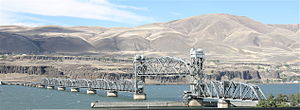Oregon Trunk Rail Bridge
Coordinates: 45 ° 38 ′ 56 " N , 120 ° 58 ′ 54" W.
| Oregon Trunk Rail Bridge | ||
|---|---|---|
|
View from the south of the Oregon Trunk Rail Bridge, 2005 (in the foreground old swing bridge and later lift bridge) |
||
| use | Railway bridge | |
| Crossing of | Columbia River | |
| place |
Wishram , Washington and Celilo Village , Oregon |
|
| construction | Truss bridge | |
| overall length | 989 m (1238 m) | |
| Longest span | 97 m | |
| opening | 1912 | |
| planner | Ralph Modjeski | |
| location | ||
|
|
||
The Oregon Trunk Rail Bridge , also Celilo Bridge is a single-track railway bridge over the Columbia River near Wishram (Washington) on the border of the states of Washington and Oregon to the United States . It was designed by Ralph Modjeski for the Oregon Trunk Railway as a link to the Spokane, Portland and Seattle Railway (SP&S). The Oregon Trunk became part of the SP&S and later merged into the BNSF Railway , which now operates the bridge for rail freight traffic as part of the connection between Wishram and Bend in Oregon.
history
The railway bridge was built near the former Celilo Falls , a series of rapids and waterfalls as well as fishing grounds and settlement areas for tribes of the Confederated Tribes and Bands of the Yakama Nation . Since this area of the Columbia River was not navigable, the 14 km long was from 1905 to 1915 to bypass on the Oregon side Celilo Canal built, that of a as a swing bridge has been executed segment of Celilo Bridge has spanned. Construction work on the bridge began in February 1910 with the construction of the workers' quarters, the bridge was completed in December 1911 and the first train left in early January 1912. With the construction of The Dalles Dam and the formation of Lake Celilo from 1957, the waterfalls and Sewer systems flooded. The entire bridge had to be raised, the swing bridge section over the Celilo Canal was decommissioned and the adjacent bridge segment was converted into a lift bridge .
description
The riveted steel bridge combines several bridge parts of different designs. The feeders on both sides of the bridge are designed as a girder bridge and result in a total length of 643 m, whereby these form a track triangle on the Washington side with the railway line on the bank side . This is followed by six truss segments of 70 m in length, as well as a 97 m lift bridge and a former swing bridge of 73 m length on the Oregon side, both of which are also designed as truss bridges . The bridge has a total length of 989 m, taking into account both sides of the track triangle, 1238 m results. The 29 pillars were erected on islands of rock that protruded from the river at low tide between September and March before The Dalles Dam opened . They are made of reinforced concrete , with the cap stones on 25 pillars and the edge stones (in both directions of flow) made of granite along their entire length .
See also
literature
- Ralph Modjeski: The Celilo Bridge. In: Journal of the Western Society of Engineers. Vol. 17, No. 3, 1912, pp. 197-211.
- Ralph Modjeski: The Celilo Bridge: Oregon Trunk Ry. In: Engineering News-Record. Vol. 67, No. 8, 1912, pp. 330-332.
- Bridge Construction on the Oregon Trunk Railway. In: Railway Age Gazette. , Vol. 52, No. 13, 1912, pp. 756-759.
Web links
- Historic photos of the Oregon Trunk Railroad Bridge. Columbia Gorge Discovery Center Photo Archive, Oregon State Univ.
Individual evidence
- ^ Ralph Modjeski: The Celilo Bridge. In: Journal of the Western Society of Engineers. Vol. 17, No. 3, 1912, p. 197.
- ^ The History of BNSF: A Legacy for the 21st Century. BNSF Railway Company, pp. 40-44. Retrieved July 22, 2017.
- ^ Katrine Barber: Celilo Falls. The Oregon Encyclopedia, Portland State Univ. and Oregon Historical Society. Retrieved July 26, 2017.
- ^ Marshall N. Dana: The Celebration of the Open Columbia. In: The Quarterly of the Oregon Historical Society. Vol. 16, No. 2, 1915, p. 107 f.
- ^ Ralph Modjeski: The Celilo Bridge. In: Journal of the Western Society of Engineers. Vol. 17, No. 3, 1912, p. 205.
- ^ Ralph Modjeski: The Celilo Bridge. In: Journal of the Western Society of Engineers. Vol. 17, No. 3, 1912, pp. 198 f.
- ↑ Woman Christens Big Celilo Bridge. The Oregonian, Jan 6, 1912, p. 10.
- ^ Ralph Modjeski: The Celilo Bridge. In: Journal of the Western Society of Engineers. Vol. 17, No. 3, 1912, p. 202.





